By Dr. Raymond Douglas Chong (Zhang Weiming)
Over 153 years ago, in 1865, a sojourner from a different shore, arrived on Gold Mountain – America. He landed on a teeming wharf at the port of San Francisco on a clipper ship from Hong Kong. After a wavy voyage of about seven weeks, he arrived in awe and fear. The sojourner was Bein Yiu Chung, my great-great grandfather.
Before him, at around 1849, his father, Cheun Saan Jeung, came to Gold Mountain on a sailboat from Hong Kong during the California Gold Rush. My great-great-great grandfather, was a poor farmer from the village of Yung Lew Gong in the county of Hoyping. Cheun Saan was our family’s first sojourner to Gold Mountain. He labored on the river beds of the Central Valley in tedious search for specks of gold, with his countrymen. He made a little fortune of golden coins and returned to his village in China.
Bein Yiu Chung also hailed from the village of Yung Lew Gong, town of Chek Seui, county of Hoyping, city of Kongmoon, within the region of Sze Yup, on the west edge of the rich Pearl River Delta of Kwantung province in Cathay. His world was a fertile land of rice and fish with beautiful evergreen panorama of vales, glens, and mesas, facing the South China. It lies on the east bank of Tan River Valley near the glorious emerald Mount of the Eight Immortals Crossing the Sea. Lew Gong means dragon hill. The five-clawed dragon was an imperial symbol of the Chinese emperors. This ancient village is surrounded by rice fields, vegetable gardens, tropical fruit orchards, and fish ponds near bamboo groves inside a majestic valley of leafy and piney woods. Stony towers, Dialous – Castle in the Sky, dot the lush vista.
Life in Yung Lew Gong
Bein Yiu was born about 1840 among poor families that farmed the fertile land. He often went to the mountains to cut firewood. He grew up amidst rebellions and despair in southern China. With the British army stationed next door in Hong Kong, the Nanking Treaty forcing China to open, and increasing numbers of Chinese workers moving abroad, it would not be long before Bein Yiu followed his father to Gold Mountain.
The First Opium War had started and by January 26, 1841 the British had officially occupied Hong Kong island. Cheun Saan watched the First Opium War unfold right in his backyard. Imagine what it must have been like: the social environment of his ancestral home had already disintegrated due to overwhelming drug addictions and now the powerful British Army was about to descend on Hoyping at any moment. What was going to happen to his young family? His only son, and your great-great- grandfather, Bein Yiu was only one; how was Cheun Saan going to protect him?

In the late 1840s, Cheun Saan and perhaps even young Bein Yiu increasingly heard about a place called Gum Saan, “Gold Mountain.” A place roughly three months away by boat where one could easily make a fortune by taking gold from the earth. Chinese in and around Hoyping and neighboring Toisan in Sze Yup were moving there in relatively large numbers.
Moreover, as Bein Yiu reached adulthood in the 1860s, several violent uprisings raged through Kwangtung province. Two of these had quite a destructive impact on Hoyping: The Red Turban Revolts and the Punti-Hakka Clan Wars. The villagers will certainly have been directly exposed to the instability, fear, and chaos that surrounded these rebellions.
Fighting reached Bein Yiu’s doorstep in Chek Seui in January 1865. The vice general of Kwangtung, Leizhou and Hainan, named Zhuo Xing, had ordered the Hakkas from elsewhere in Kwangtung to find refuge in select places in the region, including Hoyping Counties), Shenjing and Damen in Xinning County, and last but not least: Chek Seui and Dongshan in Hoyping. Hakka refugees arrived in hordes in the town of Chek Seui, looking for a new place to settle. However, the Punti (natives) of Chek Seui refused to receive them and fighting broke loose, resulting in bloodshed and casualties on both sides in the Punti Hakka Clan Wars. This happened after Bein Yiu left for the US. All in all, over 150,000 Hakka perished during the Punti-Hakka Clan Wars.
How would Bein Yiu, at the still impressionable age of 25, have felt about the conflict? Would he have seen the Hakka as interlopers, and felt it necessary to join in the violence to preserve his home? His father was on the other end of the world, who would he turn to for guidance? Would his mother have urged him to just stay away from the danger?
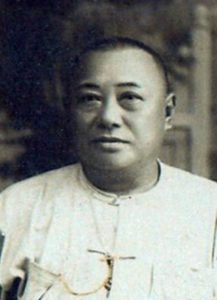
Bein Yiu had a difficult life prior to his trip to America. He made a living collecting firewood in the surrounding woods, a strenuous and monotonous job. Moreover, the job was likely unsafe, being outside the protection of the village and with so much social unrest occurring in the wider area with bandits and rebels roaming the hills and the woods. The whole of Hoyping experienced severe famine; many starved to death. These will have been utterly disturbing times for Bein Yiu. In 1865, his first wife, surnamed Zhou, gave birth to a son called Hoy Lun, my great grandfather.
It could also have been the case that Bein Yiu was preoccupied with a different matter, namely leaving home himself. Since the late 1840s, men like his father across Hoyping had been leaving overseas to make money. The utter destruction and economic misery from the Red Turban Revolts, the Punti-Hakka Clan Wars, the Taiping Rebellion, and a second Opium War (1856-1860) only added reasons to leave and brought about a mass exodus. Hundreds of thousands of Hoypingese were leaving China between the 1850s and 1880s.
Like his father, Bein Yiu left behind a young family in Yung Lew Gong. Around the time his son Hoy Long was born, Bein Yiu was saying goodbye to his family, not knowing he would ever make it back to Yung Lew Gong to see his boy grow up.
Bein Yiu was ready to go abroad. His first wife sat in front of the stove at home, with a “poker” (iron bar) in hand, tending to the fire. Bein Yiu seeing and knowing his wife’s love, could not bear to go abroad, so he stayed. However, some time later, the lure of Gold Mountain was too strong. He sadly left his wife and baby son in the village of Dragon Hill, to escape the poverty, civil war, and disasters in China, during the Qing Dynasty.
My great-great grandfather was part of this mass exodus from China. In 1865, he left for the Gold Mountain with his cousin to work on the Transcontinental Railroad. Bein Yiu was nine when his father left for the Gold Mountain. He will have likely remembered Cheun Saan taking off, not knowing if he would ever return too.
Savage Adventure – The Transcontinental Railroad
From the port of San Francisco, Bein Yiu, with his cousin, took a paddle steamer to the port of Sacramento – the second city, to start his savage adventure – to work on the Transcontinental Railroad as a coolie, a Chinese Railroad Worker.
The Transcontinental Railroad, the Iron Road, was the “Work of Giants.” From the west, Central Pacific Railroad was building from Sacramento along the Sacramento River, near gold fields, 690 miles, easterly toward towering Sierra Nevada and the High Desert. From the east, Union Pacific Railroad (UPRR), was building from Omaha aside Missouri River, westerly across the Great Plains, toward the majestic Rocky Mountains.
For four years, it was Hell on Wheels, with sweats, tears and cries, as the Army of Canton, 12,000 strong coolies, marched, from piney and leafy woods of the foothills in the Central Valley, thru solid granite mountain of Sierra Nevada, 7,000 feet high, where they craved 15 tunnels, to the Great Basin Desert of the Far West. They harshly toiled in misty cool, chilly snow, and fiery heat of myriad weathers. Bein Yiu painfully labored from California thru Nevada to Utah, amid the hinterlands of the Far West.
Railroad Labor
The Chinese were paid $30 per month, much less than White Americans.
In work gangs of 20 to 30 men, under supervision of Irish foremen, the Chinese labored to build the Iron Road for Central Pacific Railroad (CPRR). They bleakly toiled amid the tall redwoods of the foothills and through the hard rock of Sierra Nevada. They performed the most difficult and dangerous work. In the stark wilderness among ravines and rivers, they cleared and grubbed the railway, graded the railroad bed, laid tracks with ties, built earth embankments and trestle bridges, installed telegraph poles and wires, and so on. At Cape Horn above the American River, the Chinese gouged railroad beds to form a granite ledge.
The 15 tunnels in the granite mountain were the worst task for the Chinese. Donner Summit was longest at 1,659 feet and deepest at 124 feet. They used black powder in kegs from California Powder Works and later volatile nitroglycerin dynamite to blast through a craggy terrain. They endured blizzards and high snowdrifts. Over the stony summit of the Sierra Nevada, they labored in the acrid deserts of the Great Basin in Nevada and Utah toward the Great Salt Lake Valley.
At the peak of construction, the CPRR workforce had 12,000 Chinese among their 13,500 employees. They were known as the Army of Canton. Many Chinese (one estimate is 1,200) died on Transcontinental Railroad. They succumbed to explosions, avalanches, mudslides, accidents, and diseases. Many forgotten graves of Chinese are scattered along the railroad line.
Charles Crocker and James Harvey Strobridge were impressed by the diligent workmanship of the Chinese in their industrious and modest ways. They were deemed reliable and competent with their White American peers. Labor conflicts were very rare with CPRR.
But in one incident, in June 25, 1867, a mass strike occurred on the Sierra Nevada. They called for higher wages, $40 per month, and shorter working hours. Charles Crocker withheld their food from them. After one week of starvation, they relented and
returned to work under threat of a stern posse.
Work Camp Life
Under adverse conditions for four years, the Chinese encountered the chilly winters of
the Sierra Nevada and the scorching summers of the vast Great Basin Desert. They
relentlessly toiled six days per week, from dawn to dusk. They dressed in indigo frocks
and loose trousers with straw hats and leather boots with queues, a Manchu hairstyle
mandated by the sovereign of Imperial China.
An Irish foreman supervised each Chinese work gang. A headman, who spoke English,
collected the wages and ordered the supplies for his countrymen. A cook organized all
meals for the work gang.
In the morning, the cook daily prepared a simple breakfast of congee and dried fruits.
In the evening, he prepared a nutritious dinner. On Sunday, he delighted them with a
sumptuous feast. The cook prepared aromatic Cantonese meals with rice or vermicelli,
jumbled with fresh pork, duck, chicken, and sausage. He supplemented the meals with
dried cuttlefish, oyster, abalone, shrimp, scallops, squid, and soybean cakes. With
peanut oil in a wok, the cook stir-fried them with pickled vegetables, dried mushrooms,
bamboo shoots, seaweed, and spices.
Under primitive conditions, they celebrated traditional holidays, Spring Festival (New
Year), Ching Ming (ancestral worship), and Mid-Autumn Festival (harvest) with incense
sticks. During idle times, they frantically gambled at Fan Tan (a counting game), Pai
Kow (dominoes), and Pak Kop Piu (lottery). They leisurely smoked opium to relieve
the raw tedium and sorrowful angst. They tenderly reminisced and wrote letters to their
loved ones. They lived in flimsy canvas tents in groups of eight. Before dinner, they
sponged bath from hot water tubs and changed to fresh clothes. They always drank
lukewarm tea. They treated their ailments with herbs. In this austere environment,
camaraderie prevailed among the men in the work camp, for Bein Yiu.
Completion of Transcontinental Railroad
As CPRR raced easterly from the Sierra Nevada and UPRR raced westerly from the
Rocky Mountains across the desert of the Great Basin, they fervently built the railroad
tracks to connect in Utah. America was thrilled by the tremendous race between the
two powerful railroad companies. Their competition was ferocious with high tension as
federal subsidies and land grants were at stake.
In a wager of $10,000 from Thomas Clark Durant, UPRR Vice President Charles
Crocker ordered a gang of eight Irish tracklayers and 1,200 Chinese laborers, for bonus
pay, to lay 10 miles of tracks in one day, near Rozel. From 7 a.m. to 7 p.m., in 12 hours
on April 28, 1869, they achieved a new world record. Charles Crocker won his bet.
On May 10, 1869, CPRR and UPRR connected at Promontory Summit north of Great
Salt Lake near Ogden in Utah. In a well-choreographed ceremony with dignitaries and
laborers, CPRR Jupiter locomotive met UPRR Number 119 locomotive. An Irish crew
from UPRR laid the second to last pair of rails. For CPRR, eight Chinese laid the last
pair of rails. With hammers, Charles Crocker and Thomas Clark Durant pounded on the
ceremonial Golden Spike. At that moment, a telegraph cable was transmitted that said,
“D-O-N-E” across America. The Transcontinental Railroad finally linked the east coast and the west coast of America, from sea to shining sea.
After the festive ceremony, in his private train car, James Harvey Strobridge honored
the Chinese from Victory Camp in a reception where he praised them. In rostrum of the
Assembly in Sacramento, Edward Bryant Crocker said:
I wish to call to your minds that the early completion of
this railroad we have built has been in large measure due to that
poor, despised class of laborers called the Chinese, to the fidelity and
industry they have shown.
At end of Transcontinental Railroad, the Chinese left to build new railroads in the vast hinterlands of the Far West. Others returned to Chinatowns to work. The fortunate ones, Gold Mountain men, returned to their villages with gold coins.
Return Home to Yung Lew Gong
Four years after his departure in 1865, Bein Yiu returned to Yung Lew Gong, a “Gold Mountain Man.” His little boy, Hoy Lun, was now four years old and probably running around being naughty. Bein Yiu built a bungalow, a “Gold Mountain House,” in the village for his family. In 1881, after his wife Ms. Zhou passed away young, he married another woman, surnamed Wong. She gave birth to son Hoy Yun.
The economic situation improved in Yung Lew Gong with the infusion of overseas money. In the 1880s, besides occasional floods and hurricanes, Bein Yiu and his teenage son Hoy Lun will have seen the overall situation in and around their village improve slightly. Money was being sent home from abroad, to the extent that some families had become completely dependent on the funds sent back by their brothers, cousins or nephews overseas. At first, the overseas money was spent on food and other daily life essentials. After a while, families were seen to be building new homes.
In 1891, at the age of 26, Hoy Lun would follow in his father’s and grandfather’s footsteps, booking a passage for himself and his brother, Hoy Yun, to America. He will surely have heard many stories from his father about the country he was going to, but would he have known at the time that he was leaving behind a wife, Ms. Wong, who had just gotten pregnant?
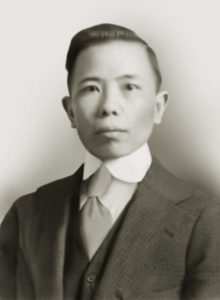
Moi Chung, my grandfather, born in 1892, grew up in the household of his grandfather Bein Yiu, now in his 50s, his step-grandmother Ms. Wong, and his mother, who will have lived with her in-laws and was also surnamed Wong.
Moi’s grandfather Bein Yiu had passed away in 1910. His family called upon a Taoist shaman (also known as “Nanwu”) to perform the rites for his funeral ceremony. These rites consisted of a series of complex traditions associated with folk religion, such as lighting incense sticks (to “light up” the path to the underworld); waving a long banner with the deceased person’s name and date of birth (to call the escaped soul back to the body and prevent it from getting lost); washing the body of the deceased with water from the river to cleanse it before its departure; and carrying out a funeral procession led by a shaman or a monk before burying the body in a wooden coffin. The shaman performed another ritual ceremony before the grave three days after putting the deceased below ground, and once again a month later. After several years had passed, the remains could be unearthed and transferred to an earthen jar.
Descendants of Bein Yiu Chung
Hoy Lun Chung, son of Bein Yiu Chung, my great grandfather, grew up in Yung Lew Gong. With his younger brother, he arrived at Boston, in Massachusetts, the Northeast, about 1892. He lived, worked and play in Chinatown of Boston, with his comrades. He successfully operated a gambling hall and an opium den as entertainment for lonely men in society of bachelors. He reaped many gold and silver pieces. He brought other businesses. Hoy Lun Chung returned to Hoyping as very wealthy gentleman. He also built a Gold Mountain House. He owned a market in Baksa in Toisan. He was so respected for his wisdom. He was chief of Yung Lew Gong.
Moi Chung, my grandfather, grew up in Yung Lew Gong, as a privileged son of Hoy Lun Chung. In 1912, on a steam boat, from Hong Kong, he arrived at port of San Francisco. He learned English at a school in San Francisco. By 1917, he left for Boston to work in Chop Suey restaurant. Later he owned the Royal Restaurant in Chinatown. From 1923 to 1936, Moi Chung was owner of Imperial Restaurant in Central Square of Cambridge. The Chop Suey restaurant catered to Americans. Later, he casually worked for Yet Quong Low’s Far East Café of Little Tokyo in Los Angeles. For 43 years, 1923 to 1966, he was separated from his second wife, my grandmother, Cun Chuen Wong.
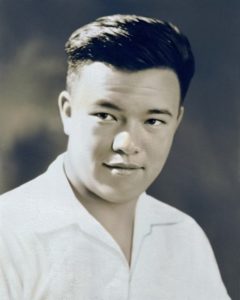
Gim Suey Chong, my father, born in 1922, grew up in Yung Lew Gong. As a paper son, with false immigration documents, he arrived in Boston in 1932 from Hong Kong thru Canada, from Vancouver to Yarmouth. He joined Moi Chung to live, learn and play in Cambridge. During the Great Depression, by 1936, he and his father moved to Los Angeles, City of Angels, in California, the Golden State. They lived in Little Tokyo near City Hall, a lively enclave of Japanese. Gim Suey Chong was mechanic for the famous China Clipper sea planes during World War II in San Francisco and in Honolulu. From 1946 to 1950, he was partner of Kubla Khan Theater Restaurant in San Francisco, Chinatown. Kubla Khan was a mystical place of American and Chop Suey cuisine, Latin dancing, and fancy show. From 1950 to 1979, he was inspector for Lockheed Aircraft Company in Burbank. And was a waiter at Far East Café during weekends. With his wife, he raised two sons.
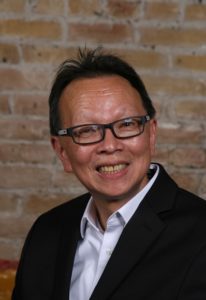
Raymond Douglas Chong, son of Gim Suey Chong, was born in New Chinatown in Los Angles. I grew up in Los Angeles River valley near City Hall. I graduated from University of Southern California and San Jose State University. Now, I work as civil engineer in Texas. I was chair of the inaugural Miss Oakland Chinatown Pageant (1988), founder and President of Oakland Asian Students Educational Services (1990-2000) in Oakland Chinatown, President of Wa Sung Community Service Club in Oakland (1991). In the zesty creative realm, I am an emerging writer (Chop Suey and Sushi – from Sea to Shining Sea), love poet, (Amour Mystique – In Intimate Passion and in Sultry Fire), song lyricist (Village of Dragon Hill: A Mystical Journey in Passion) and film director (My Odyssey – Between Two Worlds).
Ching Ming (Tomb-Sweeping Day)
During a crispy spring Sunday on May 17, 2017, in the Year of the Rooster, we held the Chong ancestor respect ritual in Yung Lew Gong. The villagers greeted me with a glorious and golden Lau Pei (Auspicious Lion) to the enchanting song of drums, gongs, and cymbals, along with yellow flag of the Chong clan. Zhang Jun Yu, my elder cousin, kindly escorted me.
The Lau Pei greeted me and my cousin at the village plaza when I solemnly entered the ancestral hall. The altar of the Village was lit by a pair of red candles. I honored Sek Chyun Zi, the village patriarch (1506) by bowing and leaving joss sticks, paper money, and rice wine at the altar. The Lau Pei heartily entered the Temple to pay respect to our ancestors and bless the offering of roast pig, baked geese and chicken, boiled duck eggs, and steam buns, plus rice wine, to Sek Chyun Zi. Lau Pei danced, pranced, and bowed in front of the Sek Chyun Zi altar.
In Chinese culture, ancestral respect is an important tradition. The good fortune of a person is associated with happiness of his ancestral spirits. Three bows show respect to one’s ancestors in heaven. A pair of red candles at the altar lights show the way out of darkness. Flowers symbolize respect and remembrance of ancestors. Food is offered to the ancestors. The smoke of joss sticks represents the ancestral spirits. Hell bank notes represent good fortune to the ancestors. Rice wine is poured on the ground for the ancestors to drink.
With Lau Pei leading the way, I arrived at my ancestral house, 9th house on the 6th alley. We repeated the ancestral respect ritual at the front door and in the parlor in front of the Zhang family altar. The Lau Pei excitedly danced inside the parlor to the mesmerizing music outside.
We reverently marched to the stony tombs of my ancestors on Fei All Sam (Hill of the Flying Swan) thru the gate of Yung Lew Gong as daisies brightly bloomed and dragonflies hastily darted and tan sparrows sweetly twitted. We hiked through the monsoon rainforest of eucalyptus on the ferny ground.
At the seven stony tombs on the ferny slope, I offered plates of food to five generations (thirty-seventh to forty-first) of Zhang ancestors, on two terraces, including Bein Yiu Chung. Cheun Saan Jeung, and Hoy Lun Chung. Burning red candles and joss sticks were placed in front of the tombs. Paper tomb flowers adorned the tomb mounds in display. Paper money lay on the ground for burning. The Lau Pai danced around this sacred ground with the haunting music. I repeated the ancestral respect ritual and bowed three times with joss sticks, paper money, and rice wine. Near end of the ritual, a villager lit firecrackers ritual to scare the evil spirits away. In poignant solitude, I sensed their gentle presence. I smelled the sweet fragrances of the wildflowers, soapwort, redbud, and eucalyptus of the monsoon rainforest. I made the final bows to my eight ancestors.
Muse
During my introspective muse in Texas, I deeply marveled at the panorama and the moment, my bamboo mind remembered the intrepid life of struggles and sacrifices of Bein Yiu Chung, my great-great grandfather, the Chinese Railroad Worker of the Transcontinental Railroad, on Gold Mountain.
AsAmNews has Asian America in its heart. We’re an all-volunteer effort of dedicated staff and interns. Check out our Twitter feed and Facebook page for more content. Please consider interning, joining our staff or submitting a story.


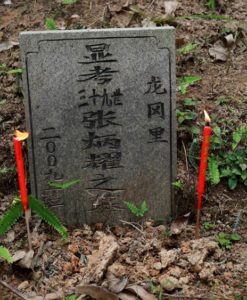


RE: APA Heritage Month: Story of my ancestors who built the Transcontinental Railroad: Wow! What a thorough, historical researched story! Thank you! I have written the multi-media Storytelling play Red Altar about my ancestors who started the fishing industry in Monterey in 1850. We have performed it throughout the country and I am finishing the book now. Friday we film it for as dvd.
I have one question. Are sure it took 3-4 months to sail here. I have seen and heard so many different response from 1 -3 or 4 months. Could you tell me where you heard 3-4 months? Thanks.
RE: APA Heritage Month: Story of my Ancestors Who Built the Transcontinental Railroad: Nancy,
Please review “Ships & Travel in the 19th century”
https://www-labs.iro.umontreal.ca/~vaucher/History/Ships_19thC/
Clipper Sailing Records
San Francisco – Hong Kong 6,100 nm usual: 45 days
record: 33 average: 135 nm/day, 5.6 knots
Ray
RE: Story if my ancestors who built the Transcontinental Railroad: Thank you Raymond!! Finally a real time!! 33-45 days from HK to California on a junk I presume. If caught in a storm and pushed past SF to Mexico, then fight current to turn north, even longer until crashed into Carmel Bay. Must have been more than scary! Thanks!
RE: Story of My Ancestors who built the Transcontinental Railroad: You mentioned Hoy Lun Chung and that he arrived in 1892. Did he get into the country as a merchant? That was the time period 10 years into the Chinese Exclusion Act.
RE: APA Heritage Month: Story of my Ancestors Who Build the Transcontiental Railroad: Arlene. You have a very good point. Most likely as merchant. Another riddle of Hoy Lun Chung to solve. Many traces of Hoy Lun Chung but I cannot find his Chinese immigration file at NARA. I need an ancestral investigator to solve these riddles. Ray